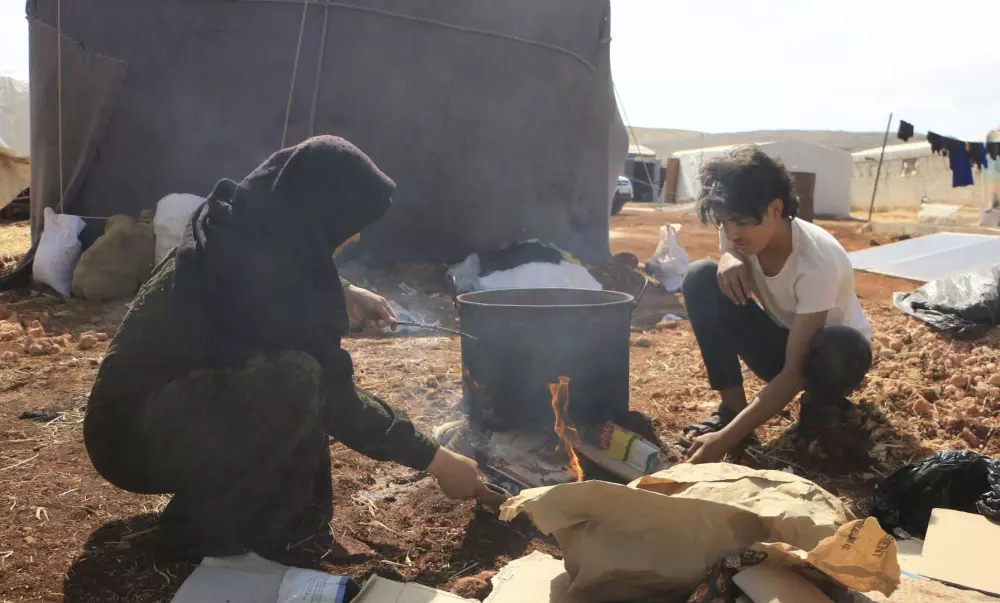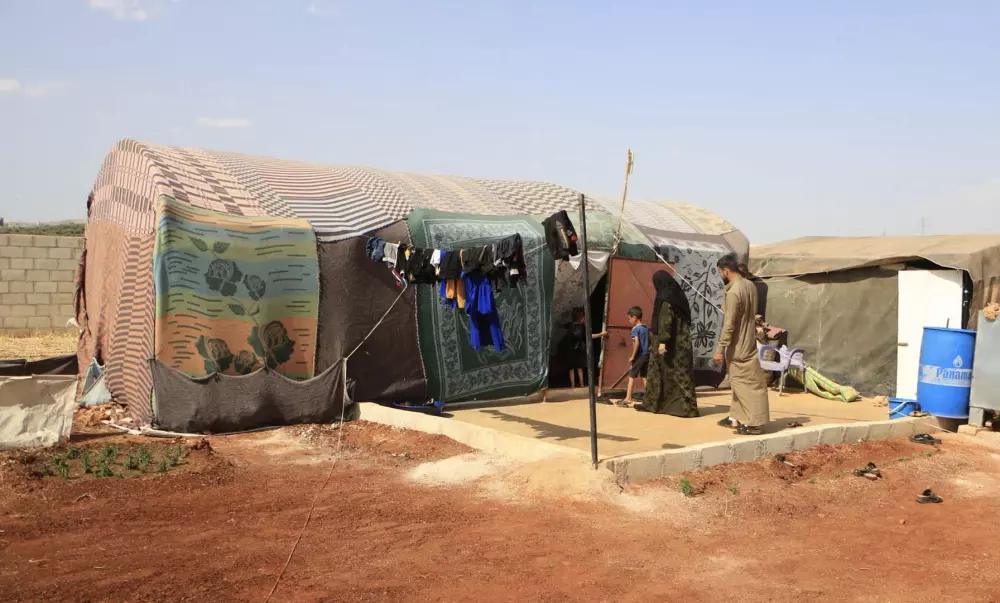It has been four months since Dalal Jomaa Hasan’s home in northwest Syria was destroyed by an earthquake, marking the sixth time she was forced to uproot her family since the outbreak of war in 2011.
The sturdy cement walls provided a few years of protection from winter downpours and boiling summers for 52-year-old Hasan and her 13 children and grandchildren, but they couldn’t withstand the quakes that decimated the region on 6 February, killing more than 50,000 people across Syria and Türkiye.
Sheltering in a small tent pieced together with tarps and blankets, Hasan and her family are now struggling to get enough to eat. The economic aftershocks of the earthquakes and runaway inflation mean they’re facing rising food prices, but dwindling food aid that officials blame on low funding levels also plays its part.
Hunger has been rising for years in northwest Syria: The UN estimated at the end of 2022 that 3.3 million people, or 70% of the region’s population, were food insecure.
Hasan, who must battle to even afford basic staples and says the only aid the family received since the quake was a basket of emergency non-food items like blankets and sponges, feels abandoned. “Everyone let us down,” she told The New Humanitarian.
On a fire of wood and cardboard next to her Idlib tent, she boiled water to make a bulgur wheat kernel and yoghurt dish, preparing food that must sustain her large family for three or four days.
Most days, she eats nothing but bread. “We, the adults, can be patient and not eat, but the kids, they can’t,” she said. “They cry, and they can’t go long without meals.”
Inflation and currency woes
Hasan and her family are trying to get by in a small makeshift camp called Fardous, in northern Idlib province. Given its proximity to the epicentre in southwest Türkiye, it was hit particularly hard by the earthquakes.
Recovery is made even harder by the fact that around 2.9 million people across the region, by the UN’s count, were already displaced within their own country.
Over a decade of fighting between Syrian President Bashar al-Assad’s army and the different rebel forces that control most of northwest Syria has left the economy in tatters.


Dalal Jomaa Hasan and her family lost their home in the February earthquakes. They have taken shelter in Fardous camp, in the northern part of Syria’s Idlib province. (Abd Almajed Alkarh/TNH)
The earthquakes made things worse in the region, where 4.1 million people — more than 90% of the population — need (but don’t necessarily get) some sort of humanitarian assistance.
Even more people required help directly after the quakes, at the same time as food prices shot up due to damaged roads, supermarkets, and bakeries.
Four months on, prices are still climbing, but experts say this is mostly due to the ongoing inflation of the Turkish lira, which has lost about 77% of its value against the dollar over the past five years, and recently hit another record low of about 21.5 lira to the dollar after last month’s presidential election in Türkiye.
Parts of the northwest controlled by the Hayat Tahrir al-Sham (HTS) rebel group adopted the Turkish lira in 2020, as an alternative to the collapsing Syrian pound.
According to Syrian political economist Karam Shaar, the move was also intended to deprive Syria’s central bank of revenue. But without a regulatory body to manage monetary policy, Shaar told The New Humanitarian the switch turned out to be a “misguided step” that has constrained economic activity and set back the humanitarian response in the region.
Most basic goods are imported from Türkiye, and inflation in the lira (plus higher prices because of the long-lasting impacts of the war in Ukraine) has hurt everyone who depends on a fixed income, as monthly food aid and wages now buy far less than they used to. By one estimate, prices have shot up 66% across the whole of Idlib province over the past year.
“The prices are so high now… not like they used to be,” Alaa Yahya, the 27-year-old owner of a butcher’s shop in Idlib, told The New Humanitarian.
A month ago sheep meat was 180-190 lira per kilo, but now he sells it for about 220, Yahya said, adding that the cost of chicken has more than doubled from 30 lira per kilo last year to almost 65.
Yahya said that business has dropped significantly — he only sells half of what he used to a year ago. He’s had to let go of 14 employees, and is now down to just one worker.
While HTS adopted the Turkish lira, it isn’t used in all the northwest, or even all of Idlib. Shaar pointed out that this has made the situation worse, as money is often lost in the exchange process. For example, he said, there are cases where the price is agreed in dollars, then paid in Turkish lira, and the change is given in Syrian pounds.
Down the street from Yahya’s meat shop, Ibrahim al-Zir, 38, runs a small supermarket that has also seen its trade decline. He noted that even the staple products are imported – another factor adding to the sky-high prices.
But it’s not just the cost of goods putting people off. “There is a lack of income, and unemployment,” al-Zir said.
Needs up, prices up, aid down
Making things worse is the fact that less physical aid is making it into the region.
The amount of assistance crossing the border is way down on last year, according to Mazen Alloush, the media and public relations officer at the Syrian side of the Bab al-Hawa border crossing, controlled by HTS and the main entry point for aid from Türkiye into northwest Syria. “The number of relief trucks has decreased to record [low] levels,” he told The New Humanitarian.
For years, Bab al-Hawa was the only crossing the Security Council authorised the UN to use to bring aid across the Turkish border into the northwest, but since the quakes al-Assad has allowed the opening and use of two additional crossings.
Between January and May, just over 2,099 trucks of aid entered through Bab al-Hawa (with 2,496 trucks passing through all three crossings), according to figures sent to The New Humanitarian by OCHA, the UN’s emergency relief body. By comparison, 3,506 trucks entered through Bab al-Hawa over the same period last year.
Sanjana Quazi, the head of the OCHA Türkiye office, told The New Humanitarian that the cross-border aid operation into northwest Syria has long been underfunded. “Alarmingly,” she said, donors have given a little over 11% of the $5.41 billion the UN has appealed for to help Syrians in 2023.
An emergency UN ask of $398 million to help Syrians after the quake is fully funded, however, and Quazi pointed out that the UN and the NGOs it works with have “scaled up the cross-border response since the earthquakes struck” due to the heightened need.
She said the UN has reached more than half a million people in the northwest with cash assistance since the earthquake — a crucial source of aid that doesn't need to be loaded onto trucks.
Ration cuts
The World Food Programme has been cutting the assistance it gives people in northwest Syria, and across the country, despite announcing a month before the earthquakes that hunger was at its highest level in the past 12 years of war, with more than one in two Syrians food insecure and malnutrition on the rise.
It’s likely worse since the earthquakes. Lina al-Qassab, spokesperson at WFP Syria, said the disaster’s impact on food insecurity is still being assessed but it’s clear it worsened the lives of millions who were already “in the grip of hunger before the earthquake”.
However, due to rising food costs coupled with funding constraints, WFP has had to “progressively reduce the rations size in Syria”, al-Qassab said, adding that it will be forced to reduce the number of people it helps by 40% as soon as July as it “urgently” requires an additional $280 million to continue its programmes.
Ahmed Muhammad al-Mustafa, 38, has received food assistance from WFP since 2019, when he fled from southern Idlib to Abu Bakr al-Siddiq camp in the north of the province.
He told The New Humanitarian the monthly WFP food aid basket — including staples like rice, oil, and flour — was enough four years ago to meet the needs of his wife and four children but is now “no longer sufficient at all, not even enough for two people”.
“We lost everything and were displaced to the camps, and we have no work,” continued al-Mustafa. “We look to the basket each month as a way to keep us and our children alive.”
‘We sleep without bread’
For Amany Qaddour, regional director of Syria Relief and Development (SRD), a humanitarian relief NGO that works in northwest Syria, the shrinking rations point to a stark reality: “The demand [for aid] simply surpasses what’s available.”
She told The New Humanitarian that already high levels of food insecurity in the region have been compounded by the earthquakes and by climate shocks like drought that have hit agricultural production. The parts of Syria most impacted by the quakes have seen major shortages of water, Qaddour added, noting that much of the region’s farmland is now being used to house people made homeless by the disaster.
“I’m terrified for the future. There are not many opportunities. Now, without any aid coming, the situation is really scary.”
This all trickles down to the suffering of people like Tareq Hasan al-Hasan, who lives in the tent next to Dalal Hasan (no direct relation) with his disabled brother, his wife, and two young children.
Thirty-year-old al-Hasan is from the same village as Hasan and, like her family, the earthquakes pushed them out of their home for a sixth time.
“Nothing is cheap anymore,” he told The New Humanitarian. “There are no job opportunities.”
An agricultural worker, al-Hasan hasn’t been able to find any employment and, with rising prices, he’s also struggling to buy even the basics.
Al-Hasan said he has asked for food from aid groups in the area but they’ve told him there isn’t enough. “The situation is so bad now [that] sometimes we go to sleep without even eating bread,” he added.
Despite the media attention after the earthquakes, al-Hasan believes the cameras have now moved on and people like him have been left to fend for themselves: “From Arab countries to the UN, everyone abandoned us.”
Al-Hasan is now extremely anxious about what tomorrow will bring. “I’m terrified for the future,” he said. “There are not many opportunities. Now, without any aid coming, the situation is really scary.”
This project was funded by the H2H Network’s H2H Fund, which is supported by the Disasters Emergency Committee (DEC) and the Foreign Commonwealth and Development Office (FCDO).
Abd Majed Alkarh reported from Idlib, northwest Syria. Hanna Davis reported from Beirut, Lebanon. Edited by Annie Slemrod.






